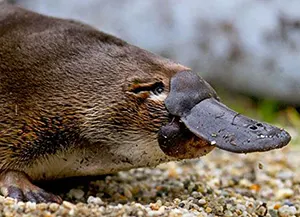
Photo: Platypus face and beak
The Platypus has a beak like a duck, a tail like a beaver, feet like an otter and venomous spurs. This odd little semi-aquatic Australian mammal is so strange that it even lays eggs like a bird. But feeds its baby milk!
When European scientists first examined a specimen of a platypus in 1798, they thought it was a hoax—a practical joke stitched together by a prankster taxidermist. But the platypus is very real, and absolutely fascinating.

Photo: Platypus face and beak
The platypus is a monotreme (an egg-laying mammal) about the size of a cat (35-50cm, 0.5-3kg). It is uniquely adapted for life in the water with its waterproof brown fur, webbed feet, and a broad flat tail for fat storage for stability.
Its most prominent feather is its huge flat rubbery black bill with thousands of sensitive electro-receptors that act like sonar, allowing the platypus to detect prey underwater. As a monotreme, it has a single opening—the cloaca—for digestion, reproduction, and excretion. But it is also a mammal and feed its babies milk.
Yes the platypus glows in the dark, specifically under UV light! Its fur is biofluorescent and shines a ghostly blue-green. Scientists still don’t know why.
The name "platypus" comes from Greek meaning "flat-footed." And its scientific name, Ornithorhynchus anatinus, translates to "bird-nosed duck-like creature." Quite fitting description for an animal that looks like a mash-up of so many creatures! The platypus is also called a duck-billed platypus.
The official name for a baby platypus is a "baby platypus". However, most people call it a puggle—cause it sounds so cute.
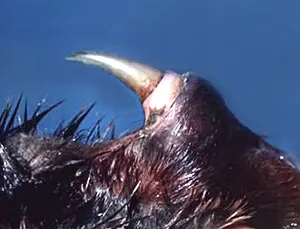
Photo: Venomous spur on male platypus's hind leg
Yes! The male platypus has sharp venomous spurs on its hind legs, It attacks by clamping its hind legs around its victim and repeatedly jabbing its venom-injecting spurs. However, the platypus isn't aggressive—it only uses its venom in defence or to fight off rival males during mating season.
While not fatal to humans, the venom causes excruciating pain and swelling. Even strong painkillers may fail to alleviate the discomfort and no antivenom is available. Small animals, such as dogs, can die from platypus attacks.
Contrary to popular belief, the platypus is not poisonous. A venomous animal injects or otherwise delivers its toxin into another animal. By contrast, a poisonous animal's entire body or parts of it may contain a harmful toxic substance if touched or eaten. Because the platypus injects its toxins, it is venomous–not poisonous.
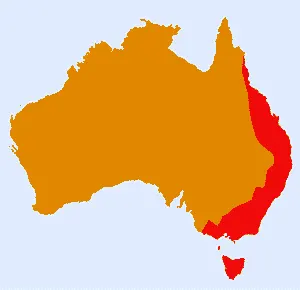
Photo: Platypus habitat map
Platypus live in freshwater creeks, streams, billabongs, and ponds with gravelly or pebbled stream-beds in eastern Australia and Tasmania. They prefer heavily wooded areas with steep and stable riverbanks into which they can dig their burrows.
A platypus establishes a home range and forages in that range. Its home range may overlap with other platypuses, but they do not have territorial disputes. Instead, they try to avoid each other, even changing their foraging schedule to do so.
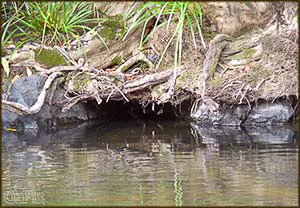
Photo: Platypus home burrow on a riverbank
Platypuses build two types of burrows. Females dig deep nesting burrows, with entrances up to 4 meters from the nesting chamber. Both males and females build shorter, 1-2 meter camping burrows for temporary shelter, often scattered throughout their home range.
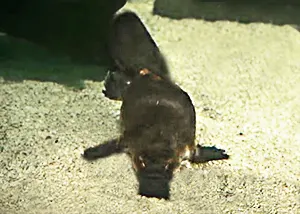
Photo: Platypus foraging for food underwater
Platypuses eat aquatic invertebrates such as water beetles, snails, shrimp, mussels, worms, mayflies, black flies, and crayfish.
The platypus hunts by sweeping its head from side to side as it swims underwater and picks up the tell-tale electrical signals given off by its prey. Then, quickly homing in on these signals, the platypus shovels them out of the stream-bed with its bill and pounces on them. It stores its catch temporarily in cheek pouches located just behind its jaw. Then, it continues to search for more prey. Resurfacing every 30-60 seconds for air, the platypus retrieves the morsels stored in its cheek pouches, grinds its food between two bony plates on their upper and lower jaws, and swallows the mashed-up food. The platypus spends 10-12 hours a day foraging for food and consumes 15-30% of its body mass in food each day.
Unlike other mammals, the platypus has no stomach! Instead, its digestive system processes food directly from the oesophagus to the intestines.
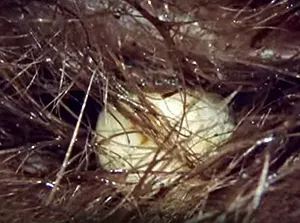
Photo: Platypus egg in mother's pouch
During the mating season between June and October, a male platypus has only one aim: to win territory and secure any females within it. To do this, the male produces venom in its rear spurs and battles other males for the female's affection. These fights are rarely fatal; the toxins usually paralyse the loser until it retreats. The victor wins whatever females reside in his newly won territory. Females do not appear to be picky about the male they couple up with. They mate with any male in their territory, assuming he is probably the biggest and strongest in the area. The courting ritual lasts for several weeks, during which time the female plays coy and refuses his advances until she is receptive. She will indicate her readiness to mate by nipping the male on his tail. He will nip hers in return, and they will swim in a circle and indulge in other aquatic courting rituals for a few days more before mating. Copulation occurs when the male partially mounts the female, inserts his four-pronged penis in her cloaca and ejaculates into her. This process takes around 10 minutes. Once copulation is complete, the male departs to find another female, and the female starts preparing her nesting burrow.
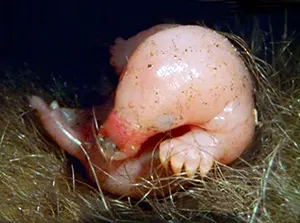
Photo: Platypus baby puggle in mother's pouch
The female lays one to three leathery white eggs, the size of small marbles (11 mm), about 2-3 weeks after mating. She positions these eggs in a slight depression on her belly and curls up its tail to cradle them. Kept warm by her, the eggs incubate for about ten days. About 9 mm in length, the young platypus hatchling breaks out of its egg by tearing the shell open with a small egg tooth on the tip of its snout and clawing its way out with its front feet.
Once the hatchlings are born, the mother's body secretes milk from two special paths on its skin (as the platypus does not have nipples like other mammals). Because its milk is deposited on the surface of the skin and doesn't offer the relative sterility of a nipple, its milk contains special antimicrobial chemicals which protect young from infection.
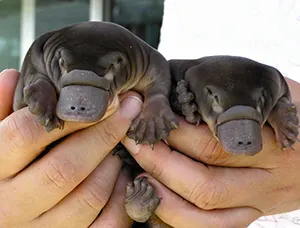
Photo: Platypus babies - puggles
Baby platypuses (sometimes called puggles) remain in the burrow for about 3-4 months feeding on milk and then on solids brought to them by their mother. When they finally emerge, they are about 80% of the length of an adult platypus and are fully furred. At this time, they need to fend for themselves, learning to swim and feed on their own. Platypuses reach sexual maturity at two years of age. The platypus has a lifespan of up to 17 years.

Video: Platypus walking
On land, the platypus walks like crocodiles and lizards. Its legs move from the side of its body rather than from under it. Furthermore, the platypus walks on its knuckles to prevent its webbed feet from getting entangled in vegetation. (Gorillas and chimpanzees also use knuckle-walking). Because a platypus is built for efficiency in water, it is not well adapted for walking on land. As a result, they rarely walk on dry land.
The platypus is an expert swimmer and diver. It swims and propels itself underwater using its large webbed paddle-like front feet and steers with its tail and rear feet. It closes its eyes, nostrils, and ears when swimming underwater and uses its super-sensitive bill to guide it through the water. A Platypus usually remains submerged for about 4 minutes but can remain submerged for as long as 14 minutes. It can swim and dive at the rate of 12 meters per minute. While foraging for food, it travels at a speed of about half a meter per second. The platypus has a very low above-water profile making it hard to spot.
Platypuses fall prey to dingoes, feral cats, foxes, large birds of prey and crocodiles . Domestic dogs, too, occasionally attack platypuses. Water-rats and goannas threaten the young platypuses in nesting burrows. Humans and climate change, however, pose the most significant risk to the survival of the platypus.
The platypus is listed as 'Near Threatened' by the IUCN. Without proper conservation, it risks becoming endangered. Efforts to protect this iconic species include habitat restoration, research, and raising public awareness.
The platypus is one of nature’s strangest and most remarkable creatures, offering a glimpse into the evolutionary past. Whether it’s their bizarre mix of features, egg-laying reproduction, or venomous defence mechanisms, the platypus continues to fascinate scientists and animal lovers alike. Protecting this unique species ensures future generations can marvel at its weird and wonderful existence.